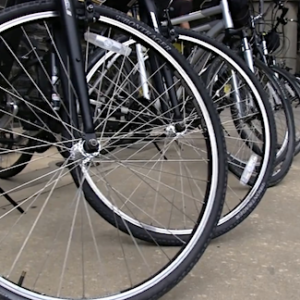Doctors’ Notes
BackBicycle Safety
Time to start cleaning off the dust on the bicycle seat and loosening the rust on the chains!
 Warmer weather will soon be here, and longer hours of daylight will brighten the gloom of the winter days past. Bike riding is great exercise and can be a wonderful time for the family to spend time together and get outdoors.
Warmer weather will soon be here, and longer hours of daylight will brighten the gloom of the winter days past. Bike riding is great exercise and can be a wonderful time for the family to spend time together and get outdoors.
But remember: SAFETY FIRST. Be sure you have all the equipment and riders ready. Your safety checklist should include…
HELMETS
Helmets are very important. Remember: you only have one head, and it’s vulnerable to trauma if you don’t protect it. A properly fitted helmet will reduce risk of traumatic brain injury by 85%.
A bicycle helmet should fit properly. See the illustration below for the proper way to fit the helmet. If you aren’t certain of the proper size, then go to a qualified cycle shop to get fitted.
BICYCLES
Bikes should be inspected carefully. Remember “ABC Quick”:
A: Air pressure should be according to tire specification. This information is on the sidewall of the tire. When in doubt, pinch the tire before each ride to make sure it has enough air in it.
B: Brakes should be in line, gapped correctly, and with a thickness greater than ¼ inch. Make certain it they’re not rubbing on the tire or spokes.Check brake lever for proper tension and function.
C: Check the cranks, cassette, and chain for wear. If you don’t know what depth the chain links should be or how to tell if the chain is skipping, have a certified bike repair shop inspect it.
Quick: Be sure Quick Releases (these secure the tires on the frame) are performing appropriately; the lever should be engaged to keep the tires on the frame.
If you’re riding during low daylight or potential foggy conditions, you need a front and a backlight as well as proper reflectors. The last test to be done is a quick short ride to make certain all parts are in working order, and that you don’t hear any rattles or extra sounds.
CLOTHING
Clothing is your extra reflector and protects you from the elements. Bright colors and warmth are important factors to consider, and clothing should be comfortably tight to the body to avoid it entangling in the mechanical parts of the bike.
Don’t forget about biking gloves for your hands — for better grip and comfort, as well as warmth on cooler days. Eyewear should be essential if you plan to go for long rides on the roadways, or off-road trails or areas with concentrations of flying bugs. Remember to tailor eyewear for the conditions: dark lenses for sunshine, clear to yellow lenses for poor lighting or fog.
ROUTE
The last thing to do is determine your route or location for a safe ride. Here’s one website to help you plan your ride: www.mapmyride.com.
Know the rules of the road and use proper hand signals to let other bicyclists and motor vehicles know what you’re planning to do. Announce your presence, and tell other bicyclists with you if there’s a car coming from ahead (“car up!”) or behind (“car back!”).
Biking is a great exercise and a lot of fun. Make safety a regular part of biking, make certain everyone with your group is ready to ride along side you, and keep on pedaling!
Dr. Lucas Godinez spends a lot of time bicycling — including an annual two-day charity ride each June to raise money for the National Multiple Sclerosis Society. You can read more about that event here.